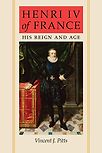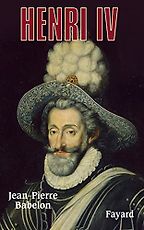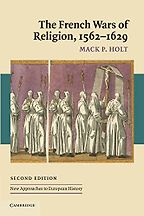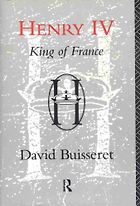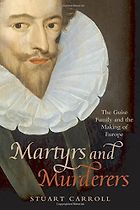My understanding of Henri IV is that he was the French monarch who brought the Wars of Religion to an end by converting to Catholicism in 1593, having been the head of the Protestant faction. He also effectively—whether deliberately or by default—was the founder of royal absolutism in France. How accurate are those two claims for Henri IV?
With modest qualifications, that’s right. Henri brought to a halt the Wars of Religion with a truce. It was not final, because you had sequels under Richelieu and then Louis XIV, ending with the revocation of the Edict of Nantes in 1685. But Henri brought the initial violence to a close and created a period of stability in which institutions of government re-established themselves. That was part of Henri’s achievement. The fact that Henri had at least a modicum of trust on both sides made it possible for him to do this and without it, the rest would not have unfolded the way it did.
He also had a strong personality, which is key to underpinning a strong monarchy. There’s no mystery there. When you have a very centralised government, with so much stress on the prince and the attributes of the prince, and then when you have people of modest ability or inability—as was the case with the last three Valois monarchs—the monarchy falls apart. But with strong kings—like Louis XI, François I, or Henri IV—it’s a very different story. I think that’s part of the tale, too.
There’s not a lot of disagreement that Henri IV laid the foundations for the very strong monarchy in France of the 17th and early 18th centuries. Academic historians like to dance away from the idea of absolutism these days, but the truth is that the monarchy was central to the whole idea of state and society in France all the way to the time of Louis XV. We can qualify that by saying what Henri really did was to co-opt or strengthen existing institutions, but the monarchy was at the centre and nothing functioned without it. 40 years of religious warfare made it obvious that you’re not going to have peace—law and order, if you will—unless you’ve got somebody at the helm who has the clout and the ability to make it work.
We’ve got two biographies of Henri IV to discuss. Let’s start with Henri IV by Jean-Pierre Babelon. What picture does this draw of him?
Babelon’s biography of Henri IV is still the standard work. It’s about a thousand pages long. Babelon was a very senior archivist in France. His whole career was spent with the documents, so there’s a depth and a richness to Babelon’s book that I don’t think anybody else can really match. He doesn’t stray very far from the standard narrative, but it’s very rich and it’s very full. The book originally came out in the 1980s, just a few years before the 400th anniversary of Henri’s accession, and it really is the indispensable book.
What I like about it is that it recognises that Henri, for much of his early life, had no likelihood of ever becoming king. He was a distant collateral relation, and there were four living sons of Henri II. There was no reason to think that at least one of them wouldn’t leave behind an heir. And so, much of Henri’s formation, much of his experience, and much of Henri’s behaviour is really conditioned by his trying to assert himself as the head of the very powerful House of Bourbon, rather than presenting himself as a future king of France.
For Babelon, this earlier status gave Henri a different outlook, together with the fact that his mother positioned him as the head of the Protestant movement in France. He had a built-in constituency, which fed into his desires to augment the importance of his own house.
The possibility of inheriting the crown didn’t become likely until the late 1570s and early 1580s, when it was evident the ruling dynasty was fading. Charles IX died without an heir; Henri III didn’t seem to be on the way to producing one; and the Duc d’Alençon/d’Anjou was not even married at that point (he was hoping to marry Elizabeth of England). It began to come into focus that quite conceivably there was going to be a dynastic crisis or failure, and Henri was the head of the next branch of the royal house. I think that unexpected change in his prospects is very important. I think some of the other people working on Henri are not so interested in that aspect and much more interested in Henri as king.
“Henri, for much of his early life, had no likelihood of ever becoming king”
Babelon also sees Henri’s personality being formed by his many, many years on the battlefield. Henri envisioned himself essentially as a soldier, in the model of his own father, Antoine de Bourbon. That was the ancestral narrative he inherited. Babelon sees Henri as a military man at heart, always quick and decisive, abrupt in a way and not interested in nonessential details.
At the same time, paradoxically, Henri was the only king of France who had to be a good politician. He constantly had to cultivate his constituency, he couldn’t count on it. He had a quick wit, a sense of humour. He also permitted that familiarity or informality expected of a captain in the field with his soldiers, a trait which endeared him to his followers.
I think Babelon does a very good job of touching all the bases, and of putting Henri in the context of the time: dynastic failure, the rivalry of the three great houses—Bourbon, Montmorency and Guise—and the underlying turmoil fueled by the existence in French society of a minority of militant Calvinists (about 10 percent of the population) and the determination of their foes to eradicate them.
Babelon does not neglect other factors which combined to give rise to social conflict, dislocation, and civil war in 16th-century France, such as the impact of the changing climactic conditions of the time, or the disruptions in the rhythms of an agricultural society caused by endless violence, thereby adding widespread peasant discontent to the mix.
Having described this perfect storm, Babelon then shows us how Henri quelled it gradually, and began the restoration of the state and the monarchy, reinvigorating the organs of government and projecting the image of a strong monarch as an indispensable element in the configuration of the state.
What does David Buisseret’s Henri IV add to that picture? Why have you included a second biography of Henri?
Buisseret is a very respected historian, with a different slant than Babelon’s. He is not especially interested in Henri as a political figure before he becomes king. Instead, he concentrates on the military history of the times and Henri as a soldier. You get a great deal about Henri as a warrior and commander of armies.
Henri was sometimes outmatched by some of the Spanish commanders like Alessandro Farnese, Duke of Parma. But Henri made good use of what skills he had and managed to hold his own over a very long period. Don’t forget that the civil wars only came to a close eight or ten years after Henri came to the throne, despite his conversion to Catholicism in 1593. During those years, Henri was constantly at war not only against factions of the Guises and others, but also against Spain and Savoy as well.
If you’re interested in military history, you’ll find more here than you will in Babelon, including Henri’s later interest in ‘national defense’: restoring or building fortresses along the borders of France, strengthening their garrisons, and initiating infrastructure projects that would also make it easier to defend the frontiers. To this end, he built canals, roads, and bridges, all of which had both commercial and military implications. He also made efforts to rebuild the French artillery, traditionally a strong arm of the French military machine.
He does cover some of the same ground that you find in Babelon, in particular the centrality and importance of the crown and the royal court as the political and administrative heart of the kingdom. He sees Henri again, not surprisingly, as the royal policeman, the person who restores law and order, re-establishing the stability that had been missing for so long, and creating the environment in which all the institutions of government could be revitalised. Buisseret doesn’t spend a lot of time on royal finances, which is an important area (he had already written a different book on that subject).
“Henri was the only king of France who had to be a good politician”
He’s also very good on the international dimension. You can’t get away from the fact that these quarrels of the 16th century were international. If Spain intervened in France, and hoped to do so in England, France was happy to reciprocate by supporting the Dutch revolt against their Spanish overlords, while Elizabeth of England aligned herself with Henri and the Dutch rebels: everyone had his fingers in somebody else’s dish, you might say. Buisseret is very good on that diplomacy.
Overall, with Buisseret, you get a different slant on Henri than you find in Babelon, so the two biographies play off one another very well.
Let’s turn to Mark Greengrass’s France in the Age of Henri IV.
Mark Greengrass is a scholar of rare distinction. This book originally came out in 1985, and the fully revised edition ten years later. Like Babelon, Greengrass has a remarkable grasp of primary sources originating in many different regions of France. What’s particularly impressive is his mastery of a great deal of the pamphlet and broadside literature of the time. There were no public opinion polls or elections back then, so if you as a historian want to get at what ordinary people were thinking, where do you go? There are a few famous chronicles from that time to cite (for example, that of Pierre de L’Estoile), but then you’re stuck with assuming that the chronicler’s opinion is representative, something that can’t be verified. Greengrass’s solution is to examine broadsides and pamphlets that originated and were widely circulated in different parts of the country, identifying themes and ideas being repeated. Using these materials, Greengrass tries to establish the mindset of ordinary people. He shows, for example, how the foot soldiers in these vast movements were moved by the theological arguments of the time. They saw themselves threatened by contrary beliefs that undermined their group identity.
Unlike the first two books, this is not so much a narrative as an analytic study of Henri’s success in restabilizing France. Greengrass argues that Henri didn’t eliminate the sources of instability, because you find them in later generations, too: religious fanatics, ambitious nobility, dissidents of one kind or another, Spanish meddling. But the ability of the established institutions to resist and contain these threats to the social order and the body politic is there by the time Henri leaves the scene, because he had done so much to reinvigorate these structures. These establishments—law courts, universities, the treasury, the financiers, the Church—all had new confidence in their ability to manage disruptions and discords, thanks to the efforts of Henri and his close associates.
He also covers Henri’s conversion, which is terribly important. The majority of the country was still strongly Catholic, but the Huguenot minority was willing—somewhat begrudgingly—to accept the olive branch that Henri held out to them.
The restoration of the state’s finances is essential in Greengrass’s account, as are various measures taken to stimulate commerce. The simple restoration of normalcy brought commerce and the commercial sector back to life. At the same time, by re-establishing royal “law and order” in the countryside, peasants and local artisans, who had suffered bitterly during the decades of civil strife, had less reason to reason to worry about being strongarmed by the local nobility.
Five Books interviews are expensive to produce. If you're enjoying this interview, please support us by donating a small amount.
To win over the nobility, the muscle in early modern societies, Henri made use of the purse, handing out offices and cash grants to bail the nobility out of the financial morass in which many found themselves in the aftermath of the civil wars.
To win over the equally important judicial and administrative elites, Henri reinstated the paulette—the right, by virtue of paying an annual fee, to pass on an office to an heir.
And so we come back to the idea that Henri makes it self-evident to the French people of that time that without a strong central power, everything falls apart. Thus, the monarchy regained its legitimacy, as did his own dynasty. In Henri’s actions, one can see the line to Richelieu, Louis XIV and the strong, highly centralized Bourbon monarchy of ancien régime France.
Let’s move on to Mack Holt’s The French Wars of Religion 1562-1629, which suggests that the French Wars of Religion weren’t ended by Henri’s accession to the throne in 1589.
Absolutely. For a newcomer to the field, I would start with Holt because he gives you the whole background to Henri’s life story, the world in which Henri grew up. When the first civil war broke out, Henri was about nine or ten years old, and conflict marked his entire life until he became king, and thereafter, for another nine or ten years.
Holt is very strong in seeing that the so-called civil wars are really one civil war. If you’re a very pedantic historian, you can divide them up into nine or ten, but it’s really one civil war that runs on and on, punctuated by brief truces for a number of months, all the way from 1562 or so, until the Edict of Nantes in 1598.
It’s the perfect storm. You have court politics and dynastic failures, social tensions, economic distress, demographic shifts, and a bitter religious divide.
Where Holt has made his mark is that a lot of 20th-century historians—under the influence of one school of thinking or another—have tried to make everything except religion the key element. It’s always something else: demography, the rivalry of noble houses, regional differences—all of which have a part to play. But the critical thing here is religion. If you don’t focus on that, you don’t understand the mentality of the people of that age. The idea of separating secular and religious didn’t exist in the minds of 16th-century people, which is a problem for historians of that period who like to separate those two out.
Holt has this concept, which I agree with, that religious identity can be as much about a community of believers as it is about a belief system, and so a breakdown of religious consensus in a religiously homogenous society means a breakdown of that society.
“These quarrels of the 16th century were international”
In the context of 16th century France, Holt demonstrates that you not only have a dynamic, vigorous Calvinist movement in France, but you also have a Catholic religious renewal in France at the same that takes place by mid-century, some of which is influenced by the Council of Trent and some of which is an indigenous reaction to the spread of Calvinism. Holt recognizes what you find everywhere in that period in Western Europe, the irresistible force meeting the immovable object—i.e. a resurgent Catholicism rising to meet the dynamic Protestant movement and thereby setting off this gigantic explosion all over Europe.
Holt also argues that Henri believed in the old formula: one king, one law, one faith. Henri concluded that his state, and ultimately the monarchy, rested on the alliance with the traditional Church, to which the majority of the population would continue to adhere. He saw the Edict of Nantes (1598) as buying time to persuade Calvinists to return to the older, still predominant Catholicism. Once he himself converted, he was baffled that not everybody was coming along with him. In after years, Henri made it very clear that those who did convert would bask in the royal sunshine: a pension or a new post or position would materialise as a reward. Holt sees a straight line between what Henri was trying to do and what Richelieu and Louis XIV did, with the latter bringing the whole thing to an end with the revocation of the Edict of Nantes.
Is there something that happens in 1629 that brings it to an end, or is that just the period he’s dealing with?
In the 1620s, a number of short wars were waged by Louis XIII and Richelieu against the Protestants. At the end of it, in 1629, they stripped the Protestants of all the military garrisons and fortresses granted by the Edict of Nantes. Huguenots were still tolerated religiously, but effectively they were disarmed and defenseless against further encroachments, paving the way for the revocation in 1685.
Let’s go on to the last book, Stuart Carroll’s Martyrs and Murderers: The Guise Family and the Making of Europe. I’m particularly interested to understand how this is important to the making of Europe.
Carroll sees the Guises as big players, not just on the French scene, but elsewhere in Europe. When Henri II died in a tournament, Mary, Queen of Scots, whose mother was a Guise, was married to the new king, François II, and the Guises used this tie to dominate the Royal Council, even managing to shove the king’s mother Catherine de’ Medici to the sidelines. For a while, they were in the catbird seat and did their best to marginalize their rivals, the Houses of Bourbon and Montmorency. Although this effort came to a halt when François II died, they continued nevertheless to make very good use over several generations of the opportunities that fell their way to build a following.
At the same time, Mary Queen of Scots’s claims on the English throne nourished their hopes that she would someday succeed to the English crown and, conceivably, would provide a way for them to influence religious and political developments in the British Isles.
Carroll also stresses that the Guises never relinquished their hopes to recover the kingdoms of Naples and of Sicily, although this created an awkward situation while they were allied with Spain and Philip II.
They had a claim to them, did they?
Yes. The Guises were a branch of the House of Lorraine, and had inherited the dynastic claims to those crowns from the House of Anjou, which had been dethroned centuries earlier by the Spanish royal House of Aragon. In addition, the House of Lorraine in earlier times had been rivals of sorts to the House of Burgundy. Their hope was that they could someday and somehow upend the heirs of the House of Burgundy in the Low Countries. Ironically, the dynastic heir to both the Burgundian and Aragonese dynasties was none other than Philip II of Spain, ruler of southern Italy and of the Low Countries, and on whom the Guises depended to subsidize their efforts in France. They couldn’t accept Spanish help in France if they were challenging Spain in southern Italy or the Low Countries, so they had to put these things on ice. It’s an interesting interplay of conflicting ambitions.
On this last point, let me mention that in another one of his books, Carroll explored how the Guises used the patronage they exercised in their royal governorships of Normandy and Champagne to build networks of ties much lower down the social scale that were of great use to them in the civil wars.
Of course, Henri was doing the same thing on his side, as were the Montmorencys as well in their respective governments.
Carroll disabuses the reader of all notions that modern nationalism, or modern ideas of patriotism, or Marxist class conflict, are going to offer useful tools for understanding that remote period. The frames of reference of people back then included none of those things.
Why were kings and princes so involved in this religious strife?
Because a key duty of the king was to protect his subjects, and that included protecting them from divine wrath. Ordinary people believed that droughts, plagues, and failed harvests were the result of God punishing you for something—and maybe that something was a wrong belief. So if you were a heretic, you would bring down divine wrath and collective punishment on the community. The king’s job was to make sure that wrong beliefs didn’t take hold. So heresy was not just a sin: heresy was sedition, because it was getting in the way of the work of the crown.
The other side of that (and you’ll find this if you look carefully at Carroll), was that if the prince himself established and embraced false beliefs and tried to impose them on the community, then he was leading his community astray. He was no longer the rightful prince, but a tyrant and not an instrument of God’s will, and was therefore removable. The Calvinists were the ones who first started thinking this way, after the St. Bartholomew’s Day Massacre, but then when Henri became king, the Guises made use of these arguments to rally Catholics to their banners, by turning the argument upside down: ‘You can’t have a Protestant king, it’s heresy. God will punish this country.’
Carroll shows that such ideas did not originate with the Guises, the Montmorencys, or the Bourbons—they simply made good use of them.
In terms of sources, unfortunately, because the Guises died out in the late 17th century, their papers, records, and books were scattered or destroyed. They certainly don’t survive in any coherent way. A few papers and letters attributed to Cardinal Charles de Lorraine, of the first generation, did survive, and have been published. We’d like to see a lot of material from the early Guises, but we don’t have that. It doesn’t exist. Carroll has made use of everything that is available, and he’s done a very good job of showing, over three generations of the family, how they managed to make themselves players of the first rank in France and abroad. It’s an excellent collective biography that’s long overdue.
When Henri converted to Catholicism and then became king, were the Guises reconciled with this or did they remain hostile because they thought he was not a proper Catholic?
They came around slowly but surely, partly because they were being driven bankrupt by decades of warfare. After it was clear that the crown was not within their grasp, their choices were exile or the bargaining table. The family itself was beginning to fracture between the Duke of Mayenne and the young Charles de Guise, son and heir of Henri de Guise, who had been assassinated at Blois in 1588. In fact, uncle and nephew were almost rivals at that point.
For his part, Henri was able to buy them off one by one. Interestingly enough, Henri never quite cut all ties to the Guises. The Guise family were closely related to him by the standards of the time, and Henri used to say that, after his own Bourbon kinsmen, they were his closest family. In spite of the armed conflict between them, Henri made use of some of the women in both families to keep open lines of communication and to signal his willingness to reconcile.
The Guises were smart enough to know when the game was done. In fact when Mayenne came to offer his allegiance, Henri made much of him and saw that Mayenne’s financial troubles were dealt with. Similarly, when young Charles de Guise made his submission, Henri astonished his entourage by addressing the young duke as “nephew” and saying some kind words about the duke’s assassinated father. It was vintage Henri!
The Guises remained prominent at court into the reign of Louis XIV. One member of the family married a legitimized daughter of Henri’s, and the penultimate duke married Henri’s granddaughter.
How does your book, Henri IV of France: His Reign and Age fit into the picture?
As this small sampling makes evident, the literature on this period is remarkably rich and deep and has benefitted not only from the burst of activity that attended the approach of Henri’s 400th anniversary year (1989) and continued thereafter, but also from the changing perspectives and focal points of historians in recent decades.
I’d like to think that my book makes good use of the work of so many of those scholars in the field of early modern Europe and provides the reader with an introduction to a fascinating period of French history and to a key player. Henri IV earned an honored place in the national narrative of his country by, as I write in the preface, “winning his crown, pacifying his subjects, and governing not simply well, but memorably…”
Five Books aims to keep its book recommendations and interviews up to date. If you are the interviewee and would like to update your choice of books (or even just what you say about them) please email us at [email protected]

